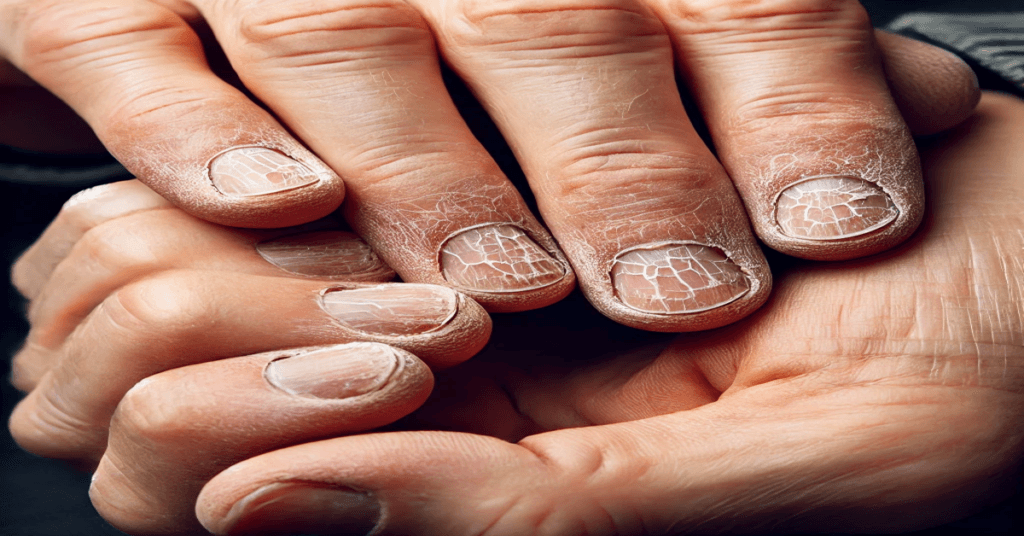Vitamin D, often referred to as the “sunshine vitamin” plays a very crucial role in maintaining overall health. This important nutrient is not only vital for bone health but also impacts your nails, skin, and hair. If your nails have been showing unusual changes, such as brittleness, discoloration, or ridges, these could be signs of vitamin D deficiency in nails. In this detailed article, we will explore how vitamin D affects nail health, identify the symptoms of deficiency, and provide actionable steps to fix it.
Why Is Vitamin D Important for Nail Health?
Vitamin D is a fat-soluble vitamin that helps your body absorb calcium and phosphorus—two minerals critical for strong bones and nails. It also supports cell growth, immune function, and inflammation reduction. Nails are composed of keratin, a protein whose production depends on adequate nutrient levels, including vitamin D. Without sufficient vitamin D, your nails can weaken, making them more prone to damage and slower to grow.
How Does Vitamin D Deficiency Affect Nails?
When your body lacks vitamin D, it can manifest in various ways, including poor nail health. Some key effects include:
- Brittle Nails: Nails might become weak and sensitive to breaking or splitting.
- Vertical Ridges: Deficiency can cause lines or ridges to appear on the nail surface.
- White Spots or Discoloration: Nails may develop white spots indicating a lack of essential nutrients.
- Slow Growth: Insufficient vitamin D can damage nail growth, making them grow slower than usual.
- Increased Susceptibility to Infections: Weak nails are more susceptible to fungal or bacterial infections.
Common Signs of Vitamin D Deficiency in Nails

1. Brittle and Weak Nails
One of the most noticeable signs of vitamin D deficiency in nails is brittleness. If your nails frequently break or chip, it may indicate a lack of essential nutrients, including vitamin D. Brittle nails often feel dry and are more likely to peel or crack under minimal pressure, making everyday tasks like typing or opening objects a challenge.
2. Ridges or Lines on the Nails
Vertical ridges can appear on the nails when the body lacks sufficient vitamin D. These ridges are often more prominent and feel rough to the touch. In some cases, the ridges may run deep, creating uneven nail surfaces. While minor ridges are normal with age, pronounced lines can indicate nutrient deficiencies.
3. Nail Discoloration
Discoloration is another common sign of vitamin D deficiency in nails. White spots may appear due to impaired keratin production. Additionally, some individuals may notice a yellowish tint which could signal underlying structural weakness in the nails. Persistent discoloration should not be ignored, as it may worsen over time without intervention.
4. Slow Nail Growth
Vitamin D is essential for cell growth. A deficiency can result in slower nail growth, making it difficult to maintain healthy nails. You might notice that your nails take much longer to grow out, leaving you with short or uneven nails for extended periods. Slow growth can also hinder the nails’ ability to recover from damage.
5. Peeling or Flaking Nails
If your nails frequently peel or flake, it may be due to weakened keratin caused by insufficient vitamin D levels. Peeling often occurs in layers and leaves nails thin and uneven. This condition not only affects the appearance of your nails but also makes them more vulnerable to further damage and infections.
6. Thinning or Soft Nails
Thinning nails that feel soft to the touch can also be a sign of vitamin D deficiency. Soft nails may bend easily and fail to maintain their natural shape, which can lead to discomfort and make them prone to tearing.
7. Nail Infections
Weakened nails are more susceptible to fungal or bacterial infections. If you frequently deal with nail infections that cause discoloration, pain, or swelling, it could be related to insufficient vitamin D levels compromising your body’s ability to fight off pathogens.
Causes of Vitamin D Deficiency
Vitamin D deficiency is more common and can result from several factors, including:
- Limited Sun Exposure: Spending too much time inside rooms or living in areas with little sunlight can reduce vitamin D synthesis.
- Dietary Deficiencies: A diet lacking in vitamin D-rich foods, like fatty fish, eggs, and fortified milk, can lead to deficiency.
- Medical Conditions: Issues like celiac disease, Crohn’s disease, or kidney disorders can impair vitamin D absorption.
- Age: Older people are at a higher risk of deficiency as their skin becomes less efficient at producing vitamin D.
- Darker Skin Tones: Individuals with more melanin in their skin may require more sunlight to produce adequate vitamin D.
How to Fix Vitamin D Deficiency in Nails

If you suspect that signs of vitamin D deficiency in nails are present, taking corrective steps is essential. Here are effective ways to address the issue:
1. Increase Sun Exposure
The most natural way to enhance your vitamin D levels is through sunlight. Aim for 15-20 minutes of direct sun exposure on your skin daily. Make sure to balance sun exposure with proper skin protection to avoid sun damage.
2. Incorporate Vitamin D-Rich Foods
Eating a balanced diet that includes vitamin D-rich foods can significantly improve your levels. Some excellent options include:
- Fatty fish like salmon, mackerel, and tuna
- Egg yolks
- Fortified dairy products and plant-based milk
- Mushrooms exposed to sunlight
3. Take Vitamin D Supplements
If dietary changes and sunlight are insufficient, consider taking vitamin D supplements. Consult your healthcare provider to determine the appropriate dosage, as excessive intake may lead to toxicity.
4. Use Vitamin D-Enriched Nail Products
Some nail care products, such as nail strengtheners and cuticle oils, are enriched with vitamin D. These can provide localized support to improve nail health.
5. Practice Good Nail Hygiene
Maintain proper nail hygiene to prevent additional issues like infections. Keep your nails clean, dry and trimmed. Avoid using harsh chemicals or nail polishes that can weaken your nails further.
6. Monitor and Maintain Overall Health
Addressing vitamin D deficiency requires a holistic approach. Ensure that your overall health is in check by managing stress, staying hydrated and consuming a nutrient-dense diet. For more tips on maintaining your overall wellness, check out Easy Tips to Stay Healthy.
When to See a Doctor
While mild signs of vitamin D deficiency in nails can often be managed at home, severe or persistent symptoms may require professional attention. Consult a doctor if you experience:
- Painful or infected nails
- Severe discoloration or deformities
- No improvement despite dietary and lifestyle changes
A healthcare provider might perform a blood test to measure your vitamin D levels and recommend targeted treatment, such as high-dose supplements or prescription medications.
Preventing Vitamin D Deficiency
Preventing vitamin D deficiency is easier than treating it. Here are some preventive tips:
- Spend time outdoors regularly to get natural sunlight.
- Incorporate vitamin D-rich foods in your daily meals.
- Consider taking a daily multivitamin with vitamin D.
- Stay active and maintain a healthy weight, as obesity can lower vitamin D levels.
For cases where vitamin D deficiency is linked to underlying hormonal issues or metabolic disorders, consulting an endocrinologist is essential. They specialize in conditions like vitamin D-related calcium imbalances or parathyroid gland issues. To learn more or schedule an appointment with an expert, visit Endocrinologist at Basaveshwar Hospital.
Additional Resource
For a deeper understanding of vitamin D’s role in overall health and recommendations for daily intake, visit the National Institutes of Health (NIH) Vitamin D Fact Sheet.
Final Thoughts
Recognizing and addressing signs of vitamin D deficiency in nails is crucial for maintaining not just nail health but overall well-being. By incorporating sunlight, nutrient-rich foods, supplements, and good nail care practices into your routine activities, you can restore and strengthen your nails effectively. If symptoms persist, consult a healthcare professional for personalized guidance. Remember, healthy nails reflect a healthy body, so take immediate steps to ensure your vitamin D levels are optimal.
Frequently Asked Questions
1. What are the early signs of vitamin D deficiency in nails?
Early signs include brittle nails, vertical ridges, white spots, and slower nail growth. These symptoms may indicate a lack of essential nutrients, including vitamin D.
2. How does vitamin D deficiency affect nail health?
Vitamin D deficiency can weaken nails, making them brittle, discolored, or prone to infections. It also slows down nail growth and reduces keratin production.
3. Can vitamin D deficiency in nails be reversed?
Yes, by increasing vitamin D intake through sunlight, a balanced diet, supplements, and good nail care practices, you can reverse the effects of deficiency on nail health.
4. How long does it take to see improvements in nails after addressing vitamin D deficiency?
Depending on the severity of the deficiency, noticeable improvements in nail health may take a few weeks to a few months, especially as new, healthier nails grow out.
5. What foods can help improve vitamin D levels for better nail health?
Foods rich in vitamin D include fatty fish (salmon, mackerel), egg yolks, fortified dairy or plant-based milk, and mushrooms exposed to sunlight.




